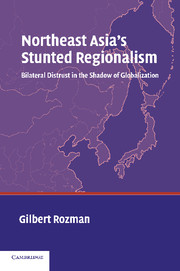Book contents
- Frontmatter
- Contents
- Acknowledgments
- Map
- Northeast Asia's Stunted Regionalism
- 1 Introduction: The Challenge of the Northeast Asia Region
- 2 Exiting the 1980s: Cold War Logic and National Aspirations
- 3 1991–1993: Border Fever and Cross-Border Duplicity
- 4 1994–1996: Civilizational Bridges and Historical Distrust
- 5 1997–1998: Strategic Partnerships and National Rivalries
- 6 1999–2000: Sunshine Policy and Security Dilemmas
- 7 2001–2003: Unilateralism and Irrepressible Regionalism
- 8 Conclusion: Lessons for Constructing Regionalism in Northeast Asia
- Index
5 - 1997–1998: Strategic Partnerships and National Rivalries
Published online by Cambridge University Press: 18 December 2009
- Frontmatter
- Contents
- Acknowledgments
- Map
- Northeast Asia's Stunted Regionalism
- 1 Introduction: The Challenge of the Northeast Asia Region
- 2 Exiting the 1980s: Cold War Logic and National Aspirations
- 3 1991–1993: Border Fever and Cross-Border Duplicity
- 4 1994–1996: Civilizational Bridges and Historical Distrust
- 5 1997–1998: Strategic Partnerships and National Rivalries
- 6 1999–2000: Sunshine Policy and Security Dilemmas
- 7 2001–2003: Unilateralism and Irrepressible Regionalism
- 8 Conclusion: Lessons for Constructing Regionalism in Northeast Asia
- Index
Summary
In the euphoria after the end of the cold war little thought was given to great-power rivalries and balance-of-power politics. Only in 1996 did great-power relations rise to the surface again. The Taiwan missile crisis called attention to Sino-U.S. differences that could result in armed combat. Suddenly, the United States had a potential rival, whose power was growing along with determination to alter the status quo. In April Sino-Russian relations were upgraded to a strategic partnership amidst talk of how these two powers could shape a multipolar world. Now the image grew of powers cooperating to balance U.S. hegemony. The Japanese-U.S. security alliance was also strengthened with warnings that security threats loomed. This indicated that the United States was responding in NEA to build a coalition of powers. Before long Sino-U.S. negotiations accelerated with China treating them as a means to forge new strategic triangles and quadrangles. Tokyo, in turn, readied an initiative toward Moscow, suggesting that the two great powers had geopolitical as well as territorial and economic reasons to talk. A high tide of geostrategic scrambling ensued, overshadowing other aspects of regionalism. There was no imminent threat that eliminated the search for regionalism or undercut growing economic ties, but cooperation was perceived as requiring an underpinning of great-power agreement and balance.
Northeast Asia lacked a security forum, although some discussions piggybacked on the new annual ASEAN Regional Forum (ARF) in SEA. For the most part, the jockeying for great-power advantage occurred in summits between two leaders.
- Type
- Chapter
- Information
- Northeast Asia's Stunted RegionalismBilateral Distrust in the Shadow of Globalization, pp. 174 - 227Publisher: Cambridge University PressPrint publication year: 2004



